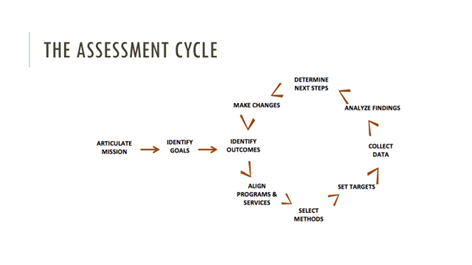As an assessment professional for the past five years, I have had the opportunity to experience several assessment cycles. We use the following assessment cycle visual to describe our efforts and the progress we hope to make on our campus.

When I first described the assessment cycle, it was to emphasize the importance of assessment being an iterative process, and that we should start the assessment cycle with re-evaluating our mission and outcomes. Five years later, and more than fifteen Assessment 101 trainings in, we have built a strong foundation that has allowed us to shift our focus to emphasizing the value of closing the loop and documenting the effectiveness of programs. This shift has been possible because we have been able to advance our organizational maturity and the effort from our entire division.
To effectively document programs/strategies, colleagues working in assessment typically spend extra effort and time during the summer helping to make meaning and articulate the work done with thoughtfulness and intentionality in order to craft lessons learned, consider trends that are coming in the fall, and identify growth opportunities for staff. This article will suggest four documents that assessment professionals in the field of student affairs should focus on during the summer to ensure they are making the most of their time and setting themselves up for a monumental academic year full of assessment successes and revelations. The four documents include a trend paper, a prioritization approach document, a clear timeline, and a growth/maturity development outline.
This blog is part one of a two part series that will provide resources and additional information about each type of document. Part one includes the trend paper and the prioritization strategy.
A Trend Paper
A trend paper is specific and unique to every institution/division. It requires documentation from each unit in a division to include synthesized unit findings that is combined with details from the institutions’ student population into five trends that leadership must be aware of for the upcoming year. This type of paper and analysis is a tool often used in the business sector. However, higher education can greatly benefit from this type of structure.
To begin gathering this information, every unit should answer the question “what trends are you monitoring in your area?”
- These details may also be collected in an end of year report, which is a great way to demonstrate use of these types of reports. Once the information is submitted from all units, the assessment professional in the division can review each response and analyze them to identify overarching trends.
- Trends are unique to the location and population that the institution serves. It can also be informed by challenges facing higher education generally such as levels of student engagement, which have come to dominate media articles this past week. Other examples of trends may include longitudinal changes and levels of student growth and development.
Documenting trends in this way can help to socialize knowledge about the students at your institution and open spaces for discussing adjustments and opportunities to collaborate to meet student needs. This document can also serve as one piece of evidence describing the impact of changes occurring in the division.
Additional resources for trend reports:
- What is Trend Analysis? https://www.wallstreetmojo.com/trend-analysis/
- How to Write a Trends Report. https://psfk.medium.com/how-to-write-a-trends-report-d669d11c5b23
- What is Trends Research? https://psfk.medium.com/what-is-trends-research-963e41ed8dc8
Prioritization Strategy
In concert with division and institution leadership, the assessment team should help to identify and clearly articulate the prioritized needs for the upcoming academic year. A prioritization statement can direct the focus of assessment work for the division, including liaisons, directors of other units, and division leadership. This prioritization may also support the division’s research agenda for the coming year.
- One prioritization strategy may be to identify a topic area for your division, such as belonging or mattering. Another strategy may be to demonstrate the effectiveness of programs through quality, utilization, skill attainment, and/or long-term impact.
The documentation and understanding of an institution’s impact on these components is challenging because of staff time and resources. At this point, most offices are not capable of documenting all these pieces in a thoughtful and thorough manner, so it is necessary to decide on the priority to maximize resources.
Additional resources for strategies that help to prioritize:
- How to Ruthlessly Prioritize Tasks to Get More Done.
- This article describes some amazing personal techniques that can be used to help prioritize your individual work. I find that I most often end up using relative prioritization based on timelines, but I started using the technique of picking only one thing and it has been a game changer this summer. Check out this article! https://zapier.com/blog/prioritize-task-list-methods/
- How to Use the Ivy Lee Method to Quickly Prioritize Your Tasks. https://hourstack.com/blog/how-to-use-the-ivy-lee-method-to-quickly-prioritize-your-tasks. Is it possible to get a team/unit to focus on only six things for a week, a month, a semester?
- Use the 1-3-5 Rule. Not all priorities are created equal and identifying the one big thing, three medium things, and five little things can help ensure resources are being used to ensure success of the organization. https://www.themuse.com/advice/a-better-todo-list-the-135-rule.
What Happens Next
Two items to note: the second part of this blog will be available in the next few weeks. We will discuss the remaining two documents, including creating a timeline and maturity outline. Follow the SAAL channels to ensure you are getting the updates. Second item, do you create other documents that other assessment professionals should know about? Let us know by emailing saassessmentleaders@gmail.com.
Blog written by Kimberly Kruchen-Spaulding, SAAL Board Secretary
Email me at kruchen@colorado.edu if you want to discuss any part of this reading or have other suggestions.
